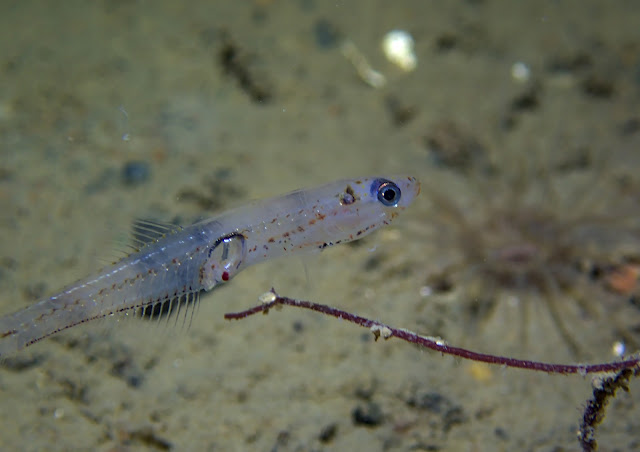Hi and ho!
This weekend's dive adventures took us to a site we have planned for quite a few times, yet seldom go to due to various reasons, this place is called Sandviken and is located a bit further in inside Gullmarsfjorden compared to our other regular sites. The site itself doesn't look much to the world, a small marina nestled in a bay, without much facilities to offer. Yet this is a good dive site, even if you need to do a surface swim to reach where it is optimal to descend into the water. Here we have both walls and the typical sloping sand mud soft bottoms that is characteristic for the fjord.
 |
| The Striped red mullet (Mullus surmuletus) is a species of fish that changes colour during the night |
Dive 1
Depth: 31 m, Time: 47 min, Temp: 14 C
Me and my buddy swam out towards the jumping tower on the other side of the bay, when we arrived to this point, we waited until the last pair was ready and there before descending into the water column. As we went down, we realized that there was a classic "Gullmar layer" this day, meaning a layer of freshwater with lots of silt and particles on the surface water layer. This layer tend to block out any sunlight from reaching further down, making any dive a night dive. Either way, when we got down below the brown surface water layer it was pitch black in the water column, which fits me more than perfectly as creatures often are more active when it is dark. When we finally had visual contact with the bottom, me and my buddy began following the slope downwards and to the left. After a little bit of that, I suddenly spot a small shape on the bottom, with a closer look I see that it is a Striped red mullet, a fish you usually don't see out during the day here. So i spent some time photographing that before continuing down the slope. At 24-ish meters i start noticing small shapes flitting about in the light column of my video lamp, these small shapes turned out to be tiny squids that were attracted by the light, unfortunately I had no way of photographing them as they were too fast and too small to get any focus on. When we reached the deepest part of the dive, I signalled to my buddy to come and look at a Norway lobster i saw there, as they had not seen one in the wild before. We continued the dive until it was time to start turning around and swim back to the starting point. Around this time, I spotted a sizeable hermit crab with a sea anemone on it's shell, a sea anemone of a species i didn't recognize. so I of course had to snap a few photos before continuing.
We surfaced at 47 minutes, swam back to land and doffed our bear before beginning the surface interval with coffee and lunch.
 |
| Likely the anemone Hormathia digitata on the shell of a hermit crab |
Dive 2:
Depth: 31 m, Time: 51 min, Temp: 14 C
After a surface intervall we got back into the waters once more, swam out to the jumping tower and started descending. I had to slow down a bit as i was having some problems with equalizing during the descent, but once that was cleared, I caught up with my buddy further down. We once again followed the slope downwards, taking it slow and easy while looking for critters of different kind. Though the more interesting critters sure did not show up on this dive, at least for my buddy pair. As we swam, my buddy signalled me that we needed to go up a bit more shallow, as they were diving with a more conservative profile compared to me on this dive, so we ascended a little bit and continued following the walls and plateaus on this dive site. Right as we were to turn around, one of the other buddy pairs came up to us and signalled "big squid further down", unfortunately my buddy's NDL did not allow us to go down more, oh well. So we turned around and started swimming back towards the starting point instead, taking it slowly. We surfaced at 51 minutes, swam back to the shore and started getting ready to head home again.
All in all, it was a nice dive day, with not too warm nor too cold weather conditions.
So until next time! Keep on swimming!
 |
| The Transparent goby (Aphia minuta) is very common, yet hard to photograph |
No comments:
Post a Comment